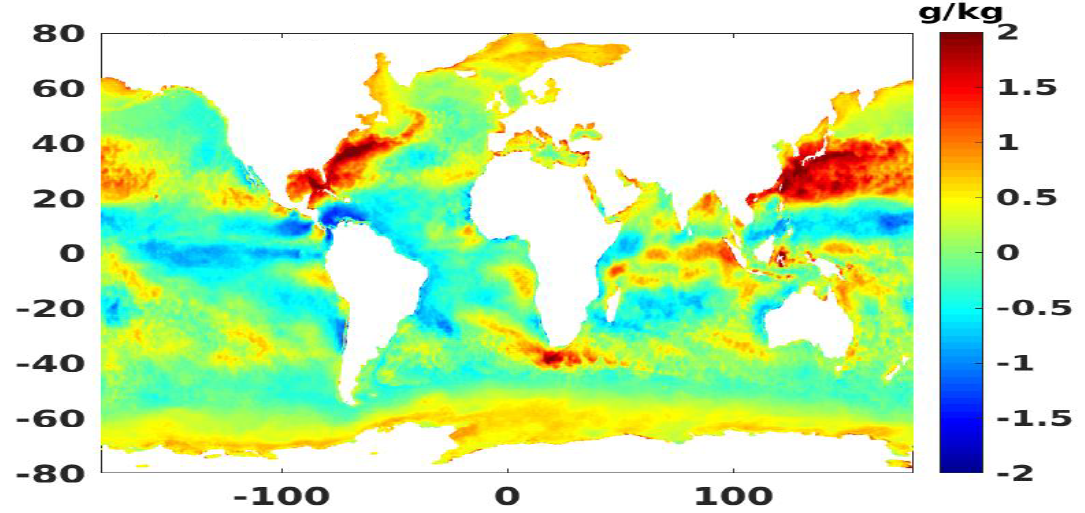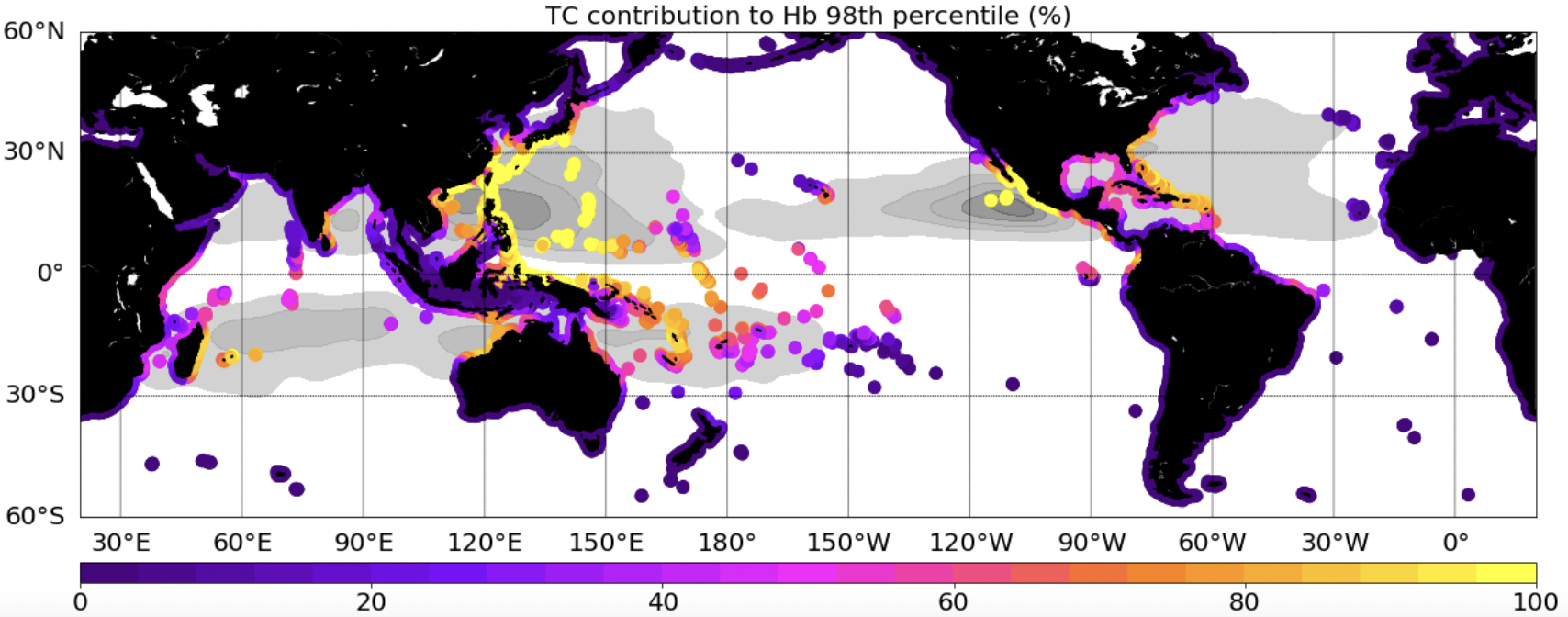Oceanographic geographical features
Type of resources
Available actions
Topics
Keywords
Contact for the resource
Provided by
Years
Formats
Representation types
Update frequencies
status
Scale
Resolution
-

Daily air-sea heat fluxes dataset on the last 27 years (1992-2018). Global coverage with 0.25° resolution. Data is mainly coming from aggregated calibrated scatterometer datasets and numerical models. Main geophysical parameters are: sensible heat flux, latent heat flux, wind speed, SST, air temperature. Latest version : 4.1 released in June 2019.
-
Sediment Profile Images (SPIs) are commonly used to map physical, biological and chemical/nutrient gradients in benthic habitats. SpiArcBase is a software that has been developed for the analysis of Sediment Profile Images (SPIs). It has been conceived to improve the objectivity of extracted information (especially the apparent Redox Potential Discontinuity (aRPD). The software presents a graphical user interface designed to enhance the interpretation of features observed on SPIs in an objective manner and to facilitate image management and structures visualization via a data base.The software also allows for the storage of generated data and the automatic computation of a benthic habitat quality index. The facilities provided within JERICONext include access to the software through free downloading and assistance in its utilization.
-

SpiArcBase is a software developed for the treatment of Sediment Profile images (SPIs). Sediment Profile Images (SPIs) are widely used for benthic ecological quality assessment under various environmental stressors. The processing of the information contained in SPIs is slow and its interpretation is largely operator dependent. SpiArcBase enhances the objectivity of the information extracted from SPIs, especially for the assessment of the apparent Redox Potential Discontinuity (aRPD). This software allows the user to create and manage a database containing original SPIs and corresponding derived pieces of information. Once you have downloaded it, you can ask for help and stablish a helpdesk.
-

This dataset provides extreme waves (Hs: significant wave height, Hb:breaking wave height, a proxy of the wave energy flux) simulated with the WWIII model, and extracted along global coastlines. Two simulations, including or not Tropical Cyclones (TCs) in the forcing wind field, are provided.
-
A global 1 km Group for High Resolution Sea Surface Temperature (GHRSST) Level 2P dataset based on multi-channel sea surface temperature (SST) retrievals generated in real-time from the Advanced Very High Resolution Radiometer (AVHRR) on the European Meteorological Operational-B (MetOp-B) satellite (launched 17 Sep 2012). The European Organization for the Exploitation of Meteorological Satellites (EUMETSAT), Ocean and Sea Ice Satellite Application Facility (OSI SAF) is producing SST products in near real time from Metop/AVHRR. Global AVHRR level 1b data are acquired at Meteo-France/Centre de Meteorologie Spatiale (CMS) through the EUMETSAT/EUMETCAST system. SST is retrieved from the AVHRR infrared channels (3.7, 10.8 and 12.0 micrometer) using a multispectral algorithm. Atmospheric profiles of water vapor and temperature from a numerical weather prediction model, together with a radiatiave transfer model, are used to correct the multispectral algorithm for regional and seasonal biases due to changing atmospheric conditions. This product is delivered at full resolution in satellite projection as metagranule corresponding to 3 minutes of acquisition. The product format is compliant with the GHRSST Data Specification (GDS) version 2. Version Description:
-
NOAA-20 (hereafter, N20; also known as JPSS-1 or J1 prior to launch) is the second satellite in the US National Oceanic and Atmospheric Administration (NOAA) latest generation Joint Polar Satellite System (JPSS). N20 was launched on November 18, 2017. In conjunction with the first US satellite in JPSS series, Suomi National Polar-orbiting Partnership (S-NPP) satellite launched on October 28, 2011, N20 form the new NOAA polar constellation. The ACSPO N20/VIIRS L3U (Level 3 Uncollated) product is a gridded version of the ACSPO N20/VIIRS L2P product available here https://podaac.jpl.nasa.gov/dataset/VIIRS_N20-OSPO-L2P-v2.61. The L3U output files are 10-minute granules in netCDF4 format, compliant with the GHRSST Data Specification version 2 (GDS2). There are 144 granules per 24hr interval, with a total data volume of 500MB/day. Fill values are reported at all invalid pixels, including pixels with >5 km inland. For each valid water pixel (defined as ocean, sea, lake or river, and up to 5 km inland), the following layers are reported: SSTs, ACSPO clear-sky mask (ACSM; provided in each grid as part of l2p_flags, which also includes day/night, land, ice, twilight, and glint flags), NCEP wind speed, and ACSPO SST minus reference (Canadian Met Centre 0.1deg L4 SST; available at https://podaac.jpl.nasa.gov/dataset/CMC0.1deg-CMC-L4-GLOB-v3.0 ). Only L2P SSTs with QL=5 were gridded, so all valid SSTs are recommended for the users. Per GDS2 specifications, two additional Sensor-Specific Error Statistics layers (SSES bias and standard deviation) are reported in each pixel with valid SST. The ACSPO VIIRS L3U product is monitored and validated against iQuam in situ data (Xu and Ignatov, 2014) in SQUAM (Dash et al, 2010).
-
A Group for High Resolution Sea Surface Temperature (GHRSST) Level 2P dataset based on multi-channel sea surface temperature (SST) retrievals generated in real-time from the Infrared Atmospheric Sounding Interferometer (IASI) on the European Meteorological Operational-B (MetOp-B)satellite (launched 17 Sep 2012). The European Organization for the Exploitation of Meteorological Satellites (EUMETSAT),Ocean and Sea Ice Satellite Application Facility (OSI SAF) is producing SST products in near realtime from METOP/IASI. The Infrared Atmospheric Sounding Interferometer (IASI) measures inthe infrared part of the electromagnetic spectrum at a horizontal resolution of 12 km at nadir up to40km over a swath width of about 2,200 km. With 14 orbits in a sun-synchronous mid-morningorbit (9:30 Local Solar Time equator crossing, descending node) global observations can beprovided twice a day. The SST retrieval is performed and provided by the IASI L2 processor atEUMETSAT headquarters. The product format is compliant with the GHRSST Data Specification(GDS) version 2. Version Description:
-
The Advanced Microwave Scanning Radiometer (AMSR-E) was launched on 4 May 2002, aboard NASA's Aqua spacecraft. The National Space Development Agency of Japan (NASDA) provided AMSR-E to NASA as an indispensable part of Aqua's global hydrology mission. Over the oceans, AMSR-E is measuring a number of important geophysical parameters, including sea surface temperature (SST), wind speed, atmospheric water vapor, cloud water, and rain rate. A key feature of AMSR-E is its capability to see through clouds, thereby providing an uninterrupted view of global SST and surface wind fields. Remote Sensing Systems (RSS, or REMSS) is the provider of these SST data for the Group for High Resolution Sea Surface Temperature (GHRSST) Project, performs a detailed processing of AMSR-E instrument data in two stages. The first stage produces a near-real-time (NRT) product (identified by "_rt_" within the file name) which is made as available as soon as possible. This is generally within 3 hours of when the data are recorded. Although suitable for many timely uses the NRT products are not intended to be archive quality. "Final" data (currently identified by "v7" within the file name) are processed when RSS receives the atmospheric model National Center for Environmental Prediction (NCEP) Final Analysis (FNL) Operational Global Analysis. The NCEP wind directions are particularly useful for retrieving more accurate SSTs and wind speeds. This dataset adheres to the GHRSST Data Processing Specification (GDS) version 2 format specifications.
-
A global Group for High Resolution Sea Surface Temperature (GHRSST) Level 2P data set containing multi-channel Sea Surface Temperature (SST) retrievals derived in real-time from the Advanced Very High Resolution Radiometer (AVHRR) level-1B data from the Meteorological Operational-C (MetOp-C) satellite. The SST data in this data set are used operationally in oceanographic analyses and forecasts by the US Naval Oceanographic Office (NAVO). The MetOp satellite program is a European multi-satellite program to provide weather data services for monitoring climate and improving weather forecasts. MetOp-A, MetOp-B and Metop-C were respectively launched on 19 Oct 2006, 17 September 2012 and 7 November 2018. The program was jointly established by the European Space Agency (ESA) and the European Organization for the Exploitation of Meteorological Satellites (EUMETSAT) with the US National Oceanic and Atmospheric Administration (NOAA) contributing the AVHRR sensor. AVHRR instruments measure the radiance of the Earth in 5 (or 6) relatively wide spectral bands. The first two are centered around the red (0.6 micron) and near-infrared (0.9 micron) regions, the third one is located around 4 (3.6) micron, and the last two sample the emitted thermal radiation, around 11 and 12 micron, respectively. The legacy 5 band instrument is known as AVHRR/2 while the more recent version, the AVHRR/3 (first carried on the NOAA-15 platform), acquires data in a 6th channel located at 1.6 micron. Typically, the 11 and 12 micron channels are used to derive SST sometimes in combination with the 3.5 micron channel. The swath of the AVHRR sensor is a relatively large 2400 km. All MetOp platforms are sun synchronous and generally view the same earth location twice a day (latitude dependent). The ground native resolution of the AVHRR instruments is approximately 1.1 km at nadir and degrades off nadir. This particular data set is produced from legacy Global Area Coverage (GAC) data that are derived from a sample averaging of the full resolution global AVHRR data. Four out of every five samples along the scan line are used to compute on average value and the data from only every third scan line are processed, yielding an effective 4 km spatial resolution at nadir. The v2.0 is the updated version from current v1.0 with extensive algorithm improvements and upgrades. The major improvements include: 1) Significant changes in contaminant/cloud detection; 2) Increased the spatial resolution from 9 km to 4 km; 3) Updated compliance with GDS2, ACDD 1.3, and CF 1.6; and 4) Removed the dependency on the High-resolution Infrared Radiation Sounder (HIRS) sensor (only available to MetOp-A/B), thus allowing for the consistent inter-calibration and the processing of MetOp-A/B/C data Version Description:
-
A Group for High Resolution Sea Surface Temperature (GHRSST) Level 4 sea surface temperature analysis produced daily on an operational basis by the Danish Meteorological Institute (DMI) using an optimal interpolation (OI) approach on a global 0.05 degree grid. The analysis is based upon nighttime GHRSST L2P skin and subskin SST observations from several satellites. The sensors include the Advanced Very High Resolution Radiometer (AVHRR), the Spinning Enhanced Visible and Infrared Imager (SEVIRI), the Advanced Microwave Scanning Radiometer 2 (AMSR2), the Visible Infrared Imager Radiometer Suite (VIIRS), and the Moderate Resolution Imaging Spectroradiometer (MODIS) on Aqua. An ice field from the EUMETSAT OSI-SAF is used to mask out areas with ice. This dataset adheres to the version 2 GHRSST Data Processing Specification (GDS). Version Description:
 Catalogue PIGMA
Catalogue PIGMA